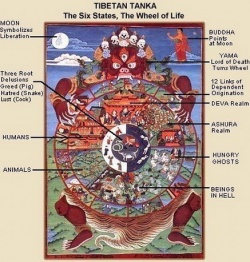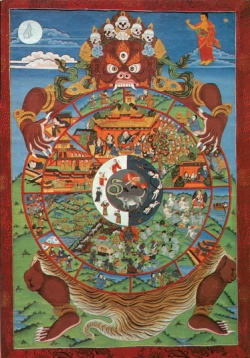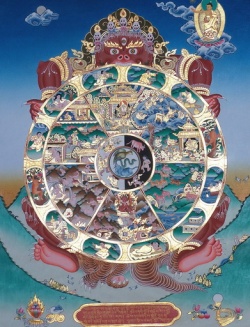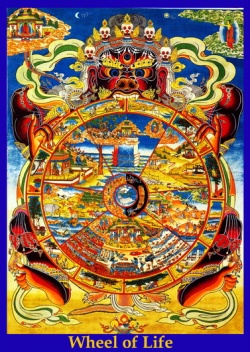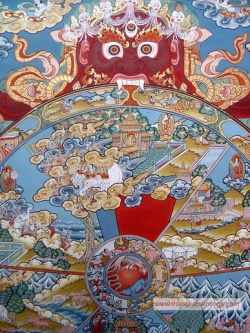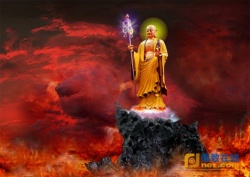Difference between revisions of "The Twelve Links – Nidanas"
| Line 16: | Line 16: | ||
In the center of the circle, [[passion]], [[aggression]] and [[ignorance]], usually depicted by a chicken, {{Wiki|snake}} and a pig respectively, represent the basic pull-push-ignore dynamic intrinsic of a [[dualistic]] ‘I’ and ‘other‘ relationship. | In the center of the circle, [[passion]], [[aggression]] and [[ignorance]], usually depicted by a chicken, {{Wiki|snake}} and a pig respectively, represent the basic pull-push-ignore dynamic intrinsic of a [[dualistic]] ‘I’ and ‘other‘ relationship. | ||
| − | As the [[ego]] and its {{Wiki|projections}} need [[constant]] maintenance, the nidana's constantly spin. | + | As the [[ego]] and its {{Wiki|projections}} need [[constant]] maintenance, the [[nidana's]] constantly spin. |
Latest revision as of 02:14, 26 February 2016
The twelve links of dependent origination, are the twelve nidana's in the chain of the causation of samsara.
The twelve nidanas are usually depicted in Tibetan Thanka's as the ‘Wheel of Life’ drawn with twelve scenes forming a circle.
In the center of the circle, passion, aggression and ignorance, usually depicted by a chicken, snake and a pig respectively, represent the basic pull-push-ignore dynamic intrinsic of a dualistic ‘I’ and ‘other‘ relationship.
As the ego and its projections need constant maintenance, the nidana's constantly spin.
1. Ignorance – Avidya (Skt), Ma-rig-pa (Tb)
(Image: An old blind person groping for his way with a cane.)
Avidya is the fundamental ignorance of the truths and the delusion of mistakenly perceiving the skandhas as a self.
Avidya represents the very beginning of the formation of ‘I’ and ‘other’. ‘I’ and ‘other’ arise together and with dependence on each other.
The formation and relationship between ‘I’ and ‘other’ occurring in an atmosphere of ignorance leads to the ever-recurring conceptual phantoms that rule the life of being in samsara.
Avidya marks the beginning of self-consciousness.
2. Impulsive Accumulation (Formation) – Samskara (Skt), Du-byed (Tb)
(Image: A potter shaping a vase on a wheel .)
As long as there is avidya there is the formation of karma: positive, negative and neutral.
This forms the rebirths in the various realms.
Avidya is the ground or the atmosphere in which karma can exist.
Sankhara marks the actual beginning of karma – the cycle of cause and effect as it relates to our existence begins here.
3. Consciousness – Vijnana (Skt), Rnam-par-shes-pa (Tb)
(Image: A monkey swinging from a tree.)
Samskara marks the beginning of being in the present as an individual.
From the sense of accumulating, there arises a more definite sense of the accumulator.
The accumulator is consciousness – a definite sense of an ‘I’ that accumulates the ‘other’.
The psycho-physical states that are being continuously supplied by samskara is experienced as a steady stream that is associated as an identity.
Sankhara causes the consciousness of the next existence - the impelling consciousness.
The consciousness that is led to that particular state, once the conditions have come together, is the consciousness of the impelled result. These two aspects of consciousness are counted as a single link since together they establish the link between two lives.
4. Name and Form – Nama-rupa (Skt), Ming-dang-gzugs (Tb)
(Image: A person (or people) on a boat.)
By the power of samskara one is linked to a womb, and there the body develops: the form and the four ‘name’ skandhas of sensation, perception, formation and consciousness.
Accumulated psycho-physical states are grouped into complexes which are then projected unto the world in the form of various attitudes or stances taken towards the world (personality).
Whatever can be viewed in the world as coinciding with that attitude is then labeled in accordance with that attitude.
That which has been perceived is seen as separate, and now, having been given a label, also becomes familiar. The familiar quality can now always be evoked by linking the name, given to that particular aspect of the world, with the attitude common to that name.
5. The Six Senses (and Sense Objects) – Sad-ayatana (Skt), Skye-mched-drug (Tb)
(Image: A house with five windows and a door.)
Salayatana represents the consolidation of one’s base of operation, which is, our sense senses and their respective sense objects.
The six inner ayatanas of the sense faculties arise.
We consolidate by experiencing possession of the six senses and sense objects.
The experience of possession begins by projecting unto the six senses and their respective sense objects, the quality of intangibility or ‘not knowing’. One further confirms the separation by exploring the senses and their sense objects.
The very act of exploring gives the experience a sense of meaning and substance.
6. Contact – Phassa (Pali) Sparsa (Skt), Reg-pa (Tb)
(Image: A couple embracing.)
The coming together of objects, sense faculty and consciousness is Phasssa.
The meeting of the senses and their respective sense objects as a substantive, meaningful experience.
Things are now meaningfully seen, meaningfully heard, meaningfully tasted, etc.
7. Feeling (Sensation) – Vedana (Skt), Tshor-wa (Tb)
(Image: A person with an arrow in their eye.)
From vedana arises sensation: pleasurable, painful and neutral.
Contact is experienced as almost too much to handle.
Its nature – fundamentally sharp, shocking, unconditional, beyond categories or meaning, is not completely hidden by dull meaningfulness.
One welcomes contact between the six senses and their respective sense objects as ”the first real experience of this and that, which is the world outside.”
The sense of welcoming contact seem to be the very essence of feeling.
8. Craving – Tanha (Pali), Trishna (Skt), Srd-pa (Tb)
(Image: A woman offering a drink to a man.)
The feeling of welcoming becomes hunger for more contact to further our sense of territory.
Tanha exemplifies most clearly the compulsive speed inherent in all the nidanas.
This compulsive speed seems to be the result of the interplay between hope of securing one’s sense of existence and the fear of losing it.
Since at no point, in the nidana process, is there found any definite, permanent justification for our version of existence, to stop our search for ultimate security at any point would bring us face to face with the truths of impermanence, ’egolessness’, and suffering.
We would be confronted with our speed, which is pain itself, and the non-substantial quality to our achievements that is the echo of that unconditional space that seems so threatening to us.
Propelled by hope and fear, we hunger for the world of ‘this and that’ as yet another attempt to attain ultimate confirmation and escape its opposite.
There then develops a desire not to be separated from pleasurable sensations and to be free from painful sensations.
9. Grasping – Upadana (Skt), Len-pa (Tb)
(Image: A man plucking fruit from a tree.)
As craving increases, it develops into grasping, that is, actively striving never to be separated from what is pleasurable and to avoid what is painful.
“Wishful desire is not enough”.
We actually have to lay our hands on the object of our craving.
We feel we need the reassurance of solid footing.
And so, you “run out of this stuffy castle and roam around the grounds”…
”You pick up fruits and eat them”…”
It is very reassuring to hold them, even more so to bite into them without peeling them”…
However, the compulsive quality to our grasping wears thin.
Impending insecurity propels us to further secure our relationship with the ‘other’.
10. Becoming – Bhava (Skt), Srid-pa (Tb)
(Image: A beautiful bride (or a couple making love, or a pregnant woman.)
Through upadana one acts with body, speech and mind, and creates the karma that determines one’s next existence.
We begin to actively identify with the focus of our grasping.
We identify, with our concepts and the meaning imbued phenomenal world, with the hope of further enriching our sense of existence.
We, both consume and allow to be consumed by what is grasped.
(One who identifies with (consumes) anger, allows to be consumed by anger, thus becoming an angry person.
One who identifies with a sunset, thus becomes one who enjoys a sunset.)
“This sensual overindulgence invites proof, and you want the evidence of being father and mother to provide a sense of legitimacy. This leads us to the next nidana”.
11. Birth – Jati (Skt), Skye-ba (Tb)
(Image: A woman giving birth.)
Through the power of this becoming, one is reborn in a particular birthplace whenever the necessary conditions are assembled.
Having become ‘somebody’ due to our identification with our projected substantive world, one acts in accordance with that identification.
By this action, one gives birth to a new situation.
(As Chogyam Trungpa Rinpoche said: “in a situation of murder, hate gives birth to a corpse.”)
The birth of a new situation provides us new possibilities for identification, which in turn can have further consequences.
This is the beginning of an endless karmic cycle.
The karmic chain of events, in which we may find ourselves in, manifest in six different, basic patterns. These are the six realms of being.
12. Old Age and Death – Jara-marana (Skt), Rga-shi (Tb)
(Image: Bearers with a corpse .)
Following rebirth there is a continual process of aging as the aggregates change and develop; and eventually there is death when the aggregates finally cease.
Throughout the nidana process, one’s striving for ultimate security has been dependent on the compulsive speed by which we turned away from accepting the impermanent, non-substantial and painful quality of our substance-projected world and accomplishments.
We have continued, with this compulsive process, up to the eleventh nidana where our actions actually precipitate consequences for ourselves and others.
As there is no other world and no other self, we are stuck with our creations.
With an ever-increasing sense of emptiness, we find ourselves unable to manage the massive worlds we have created. Our created worlds falls apart becoming “the inspiration for the charnel ground.”
At this point the cycle begins a new.
Summary
“In the beginning there is existence blind and without knowledge; and in this sea of ignorance there are stirrings formative and organizing. From this there arises awareness which begets organisms that live as individual beings.
These develop the six fields, that is, the five senses and the mind.
The six fields come in contact with things.
Contact begets sensation which creates the thirst of individualized being.
This creates a cleaving to things which produces the growth and continuation of selfhood.
Selfhood continues in renewed births.
These renewed births of selfhood are the cause of suffering, old age, sickness and death,
They produce lamentation, anxiety and despair.” (The Gospel of Buddha by Dr Paul Carus)
